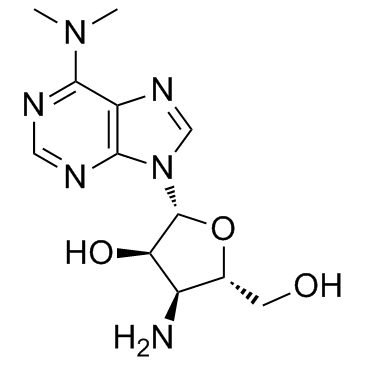Stylomycin aminonucleoside

Stylomycin aminonucleoside structure
|
Common Name | Stylomycin aminonucleoside | ||
|---|---|---|---|---|
| CAS Number | 58-60-6 | Molecular Weight | 294.310 | |
| Density | 1.7±0.1 g/cm3 | Boiling Point | 595.6±60.0 °C at 760 mmHg | |
| Molecular Formula | C12H18N6O3 | Melting Point | 235℃ (Decomposition) | |
| MSDS | Chinese USA | Flash Point | 314.0±32.9 °C | |
| Symbol |

GHS08 |
Signal Word | Warning | |
|
Diagnostic and predictive performance and standardized threshold of traditional biomarkers for drug-induced liver injury in rats.
J. Appl. Toxicol. 35(2) , 165-72, (2014) Traditional biomarkers such as alanine and aspartate aminotransferase (ALT, AST) and total bilirubin (TBIL) have been widely used for detecting drug-induced liver injury (DILI). Although the Food and Drug Administration (FDA) proposed standardized thresholds ... |
|
|
Cyclosporine A protects podocytes by regulating WAVE1 phosphorylation.
Sci. Rep. 5 , 17694, (2015) Accumulating evidence suggests that podocytes are direct targets of many classic antiproteinuric drugs. The immunosuppressive drug cyclosporine A (CsA), which is a calcineurin inhibitor, is used to treat proteinuric kidney diseases. One novel mechanism by whi... |
|
|
Fluvastatin attenuated the effect of expression of β1 integrin in PAN-treated podocytes by inhibiting reactive oxygen species.
Mol. Cell Biochem. 398(1-2) , 207-15, (2014) It is well accepted that β1 integrin plays a key role in maintaining normal podocytes form and functions; however, its mechanism of the potential protective effect remains unclear. Furthermore, the investigation and understanding of the non-lipid-dependent re... |
|
|
Sialic acid attenuates puromycin aminonucleoside-induced desialylation and oxidative stress in human podocytes.
Exp. Cell Res. 320(2) , 258-68, (2014) Sialoglycoproteins make a significant contribution to the negative charge of the glomerular anionic glycocalyx-crucial for efficient functioning of the glomerular permselective barrier. Defects in sialylation have serious consequences on podocyte function lea... |
|
|
Kaposi's sarcoma-associated herpesvirus viral interferon regulatory factor 4 targets MDM2 to deregulate the p53 tumor suppressor pathway.
J. Virol. 83 , 6739-47, (2009) Cells infected by viruses utilize interferon (IFN)-mediated and p53-mediated irreversible cell cycle arrest and apoptosis as part of the overall host surveillance mechanism to ultimately block viral replication and dissemination. Viruses, in turn, have evolve... |
|
|
CXCL10 induces the recruitment of monocyte-derived macrophages into kidney, which aggravate puromycin aminonucleoside nephrosis.
Clin. Exp. Immunol. 180(2) , 305-15, (2015) The mechanism responsible for trafficking of monocyte-derived macrophages into kidney in the puromycin aminonucleoside model of nephrotic syndrome in rats (PAN-NS), and the significance of this infiltration, remain largely unknown. CXCL10, a chemokine secrete... |
|
|
Multiple cellular mechanisms related to cyclin A1 in prostate cancer invasion and metastasis.
J. Natl. Cancer Inst. 100(14) , 1022-36, (2008) Cyclin A1 is a cell cycle regulator that has been implicated in the progression of prostate cancer. Its role in invasion and metastasis of this disease has not been characterized.Immunohistochemistry and cDNA microarray analyses were used to assess protein an... |
|
|
Podocyte autophagic activity plays a protective role in renal injury and delays the progression of podocytopathies.
J. Pathol. 234(2) , 203-13, (2014) The progression of podocytopathies is quite variable among patients and the underlying reason for this remains unclear. Here, we report that autophagic activity in podocytes plays a critical role in controlling the progression of podocytopathies. Morphologica... |
|
|
Renoprotective potential of Macrothelypteris torresiana via ameliorating oxidative stress and proinflammatory cytokines.
J. Ethnopharmacol. 139(1) , 207-13, (2012) Macrothelypteris torresiana is traditionally used in Chinese folk medicine for the treatment of edema for patients suffering from kidney/bladder problems due to its satisfactory therapeutic effectiveness.The aim of this study was to investigate the renoprotec... |
|
|
The cytoprotective role of autophagy in puromycin aminonucleoside treated human podocytes.
Biochem. Biophys. Res. Commun. 443(2) , 628-34, (2014) Autophagy is a ubiquitous catabolic process involving degradation of damaged organelles and protein aggregates. It shows cytoprotective effects in many cell types and helps to maintain cell homeostasis. In many glomerular diseases, podocyte damage leads to th... |